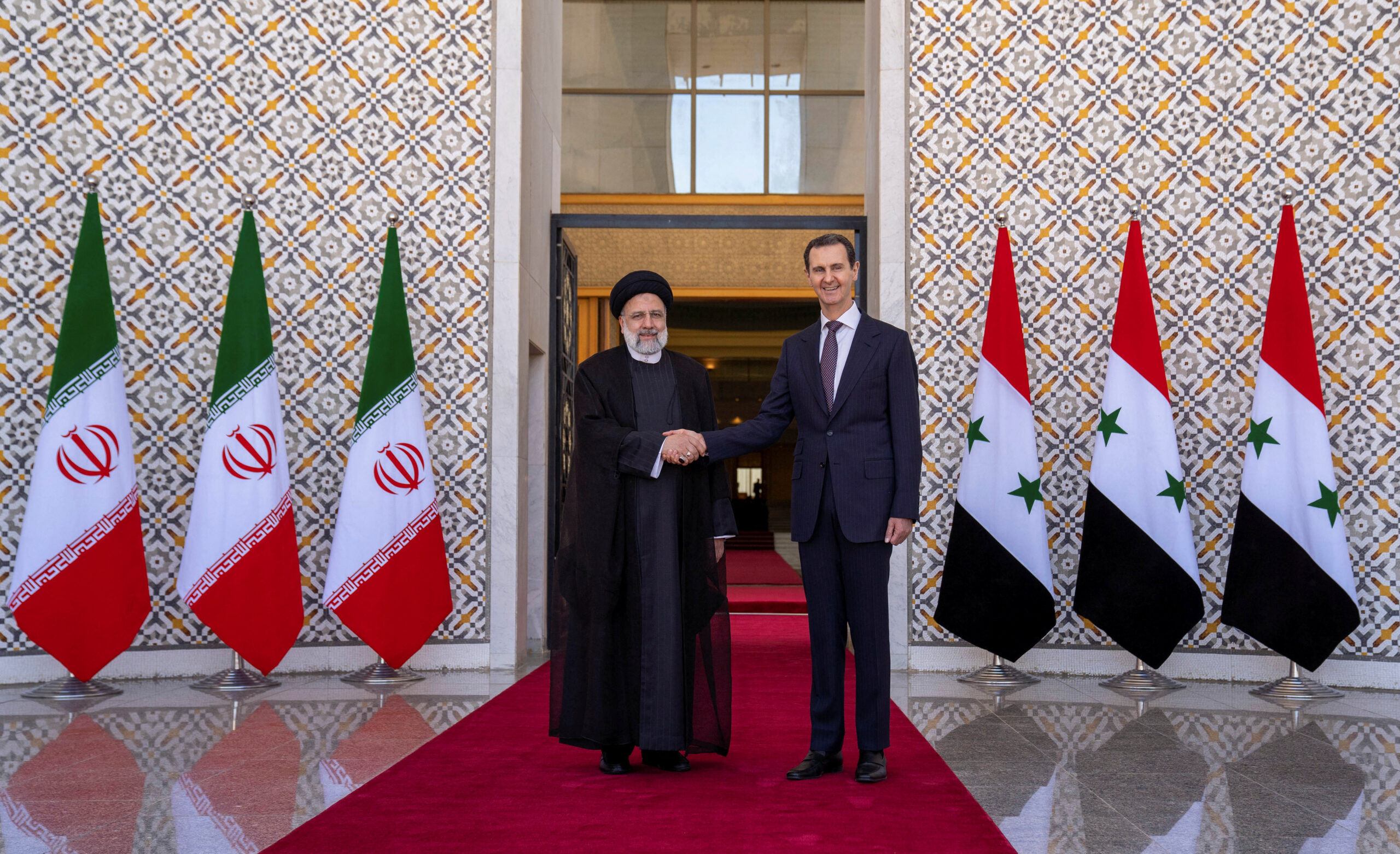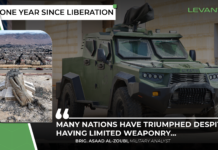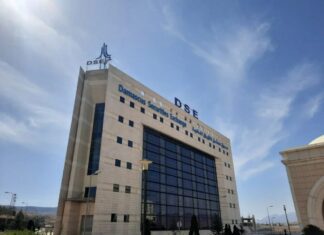
Read Part I Here
Sympathies of a Shared Struggle
Both, the Syrian revolution and the Palestinian resistance, involve Sunni Muslim majority societies under non-Sunni minority rule. The Assad regime in Syria, predominantly Alawite, has oppressed the Sunni majority, paralleling the Israeli occupation, which marginalizes the predominantly Sunni Palestinian population. Palestinians and Syrians are no strangers to living in police states, arbitrary arrests, enforced disappearances, and prisons full of sexual violence and physical, and psychological torture under systems that victimize men, women, children, and elderly alike.
“Our struggles in the Palestinian and Syrian context are very similar. In Palestine, they are resisting violent occupation, colonization, and an apartheid regime. In Syria, we are resisting a dictatorial authoritarian regime,” said Razan Saffour, a Syria advocacy specialist.
The conflicts in occupied Palestine and Syria have been protracted and bloody affairs causing significant forced displacement. The 13-year-long Syrian revolution has created millions of refugees and internally displaced persons (IDPs), similar to the Palestinian experience of displacement due to Israeli occupation and military actions. Both the Zionist and Assad regimes have created and implemented policies of engineered demographic change and expulsion of indigenous populations, often based upon sectarian or ethnic lines.
Palestinian refugee camps in Syria, such as Yarmouk, were ruthlessly attacked and destroyed by the Assad regime, exacerbating both, the Syrian and Palestinian refugee crises. Thousands of Palestinians were killed, and over 100,000 were displaced to other countries. Syrian revolutionary activists and residents of northwest Syria have expressed solidarity with Gaza, highlighting the shared experience of displacement and suffering.

Syrians and Palestinians have been the victims of numerous war crimes. The Assad regime has been accused of using chemical weapons, targeting hospitals, and committing other atrocities. Similarly, Israeli military actions in Gaza have been condemned for disproportionate use of force and targeting civilian infrastructure.
Israeli and Assad regime forces utilize the same tactics of corralling populations into de-escalation or safe zones before bombarding the vulnerable displaced populations as well as targeting schools, homes, residential neighborhoods, refugee and IDP camps, hospitals, medical infrastructure, and personal and weaponizing aid through starvation and siege tactics.
Scenes of cities like Homs, Hama, Aleppo, and those of Gaza are indistinguishable in the total destruction and annihilation visited upon them by brutal aggressors. “When Syrians see the destruction in Gaza, we sympathize, and we remember what happened in Ghouta and Aleppo. We see the Israelis hitting hospitals and schools and killing people on a huge scale, and it’s exactly the same process,” said Robin Yassin-Kassab, an author on Syria.
Palestinians and Syrians are no strangers to feelings of abandonment by the world and the international community; they have faced limited and often inconsistent support from the international community. Despite widespread recognition of their plights, political and strategic considerations have often led to a lack of meaningful intervention or support. Syrian revolutionary activists note that while Syrians support the Palestinian cause, the Syrian regime has historically used it to increase oppression within Syria. This geopolitical manipulation has sometimes divided the Syrian and Palestinian movements which share a long and often complicated history going back decades.
Assad: Allies, Enemies & Iran’s “Axis”
Despite a semblance of stability, the Assad regime remains politically and militarily vulnerable. More than a third of Syria is outside Assad’s control, and his regime’s survival is heavily reliant on Russian and Iranian support. The Syrian army has collapsed, forcing Assad to depend on these external allies to maintain his grip on power.
Assad’s forces, backed by Russia, continue attacks in northwestern Syria, while Israeli bombings of Iranian targets and threats from ISIS persist. Internally, Syria’s economic situation is dire, with over 90% of the population living in poverty. Prolonged peaceful demonstrations in Suwayda Governorate further illustrate the regime’s instability and inability to address internal dissent.
Syria under Bashar historically lacks action against Israel. The nature of the regime’s opposition to Israel has been a subject of much debate and analysis as the last 20 years have been among the most peaceful between the two nations. Despite this, the Gaza conflict provides Assad with a propaganda opportunity to divert attention from his domestic failures by invoking the Palestinian cause.
The relationship between the Assad regime and Iran has transformed significantly over the last decade. Initially, a strategic alliance forged by Assad’s father, Hafez al-Assad, this bond has deepened into what many now describe as “absolute guardianship” by Iran. The Iranian Revolutionary Guard’s presence and the spread of sectarian militias underscore Tehran’s control over significant areas of Syria.
The Syrian revolution marked a turning point, with Iran’s Revolutionary Guards intervening decisively to support Assad against the popular uprising. This intervention cemented Assad’s dependency on Iran, transforming Syria into a client state under Iranian influence. Tehran now wields significant control, seeing Syria as a strategic corridor for transporting weapons to Hezbollah in Lebanon and as a regional logistical base.

Despite provocations, Iran has maintained a policy of “strategic patience,” avoiding full-scale confrontation with Israel. Tehran’s measured responses, even after attacks on Iranian targets in Syria, reflect a calculated approach to preserve its deep-rooted influence in Syria without escalating to a broader war.
Iran’s restraint is driven by the need to protect its extensive investments in Syria and avoid jeopardizing its influence. This cautious stance aligns with Iran’s broader strategy of using proxies across Lebanon, Syria, Iraq, and Yemen to exert regional influence while avoiding direct military confrontations that could invite overwhelming Western retaliation.
The Assad regime’s survival is inextricably linked to the support and strategic decisions of Iran and Russia. Both countries use Syria as a pawn in their broader geopolitical strategies, with Assad’s regime acting as a dependent client rather than an independent ally.
This dependency underscores the fragile nature of Assad’s rule and the complexities of Middle Eastern geopolitics. The interplay between Iranian ambitions and Russian strategic interests in Syria continues to shape the regional landscape, with Assad caught between these external powers.
Assad’s Invisible Intifada
Unlike the widespread and significant demonstrations in solidarity with Gaza seen in cities like Amman, Baghdad, Idlib, Sanaa, Rabat, Tokyo, New York, and London, Damascus has witnessed minimal activity. The few marches and vigils that have occurred, particularly in Palestinian refugee camps, are negligible in scale while support abroad has been ongoing.
Experts attribute this to the Assad regime’s intense fear of demonstrations and its strategic decision to avoid further regional conflicts. This caution reflects a significant shift from Syria’s historic stance as a vocal supporter of the Palestinian cause, often used to assert moral and political leadership in the Arab world.
Assad’s regime has maintained a low profile regarding the Gaza conflict. Despite the symbolic importance of Gaza to the Palestinian cause, the regime’s public statements and actions have been muted, reflecting a strategy of avoiding entanglement in the regional conflict. This restraint contrasts sharply with Assad’s 2021 assertion that Syria’s support for Palestine is unwavering and integral to its national policy.
The relationship between Assad’s Syria and Hamas deteriorated significantly after Hamas supported the Syrian revolution during the 2011 uprising. Although there have been attempts at rapprochement, deep-seated grievances linger. Despite this, Assad’s regime may eventually find it pragmatic to re-establish a working relationship with Hamas, especially in the context of the broader “axis of resistance” led by Iran and including Hezbollah.
However, Assad values his renewed diplomatic ties with the UAE, which opposes groups like Hamas. The UAE’s recent diplomatic outreach to Damascus, including the appointment of an ambassador, signals a potential shift in Syria’s regional alliances, influenced by the UAE’s vision of regional stability and economic development.
Iran and Hezbollah seek to integrate Damascus back into a united front with Hamas to solidify the axis of resistance. However, Assad’s government must navigate its relationships with these actors while also considering its ties with the UAE and other Sunni-led states that oppose Iran’s influence leading to a policy of avoiding strong shows of support for Hamas or meaningful involvement in the Palestinian conflict.
A Cowardly Lion & Paper Tiger
The Assad regime has adopted a “neutral stance” to avoid provoking Israel and the US. This neutrality is evident in its controlled response to the Gaza conflict and minimal military engagement against Israel. The regime’s focus remains on avoiding direct confrontation, which could destabilize its fragile hold on power.
The UAE reportedly conveyed Israeli warnings to Assad, “advising” against involvement in the Gaza conflict, saying if Syria was used against them “they would destroy his regime.” These warnings highlight the delicate balance Assad maintains to avoid military escalation with Israel while navigating regional and international pressures.

The Assad regime tightly controls public demonstrations, allowing only those that receive security approval. This control was evident when a solidarity demonstration for Gaza was quickly dispersed once it grew too enthusiastic. The regime’s cautious approach aims to prevent any form of public unrest that could threaten its stability.
Historically, Assad’s support for the Palestinian cause has been opportunistic, aligning with his regime’s survival needs. The current restrained approach towards Gaza reflects a continuation of this strategy, prioritizing domestic control and leveraging regional dynamics for the regime’s benefit.
Assad has lost the influential regional role that Syria once played under his father. Syria’s current foreign policy is significantly shaped by the interests of Iran and Russia, limiting Assad’s ability to independently maneuver in regional politics.
The regime’s relationship with Israel is marked by covert security cooperation, aimed at maintaining Assad’s hold on power, his regime places priority on survival over ideological commitments to the Palestinian cause.
Assad’s muted response to the Gaza conflict reflects a calculated strategy to maintain the status quo and its precarious hold on power. Balancing relationships with regional powers, prioritizing domestic control, and avoiding direct confrontation with Israel are central to this approach. The regime’s actions reveal a significant shift from previous actions of support for the Palestinian cause, driven by pragmatic considerations of maintaining and increasing power locally and regionally.








